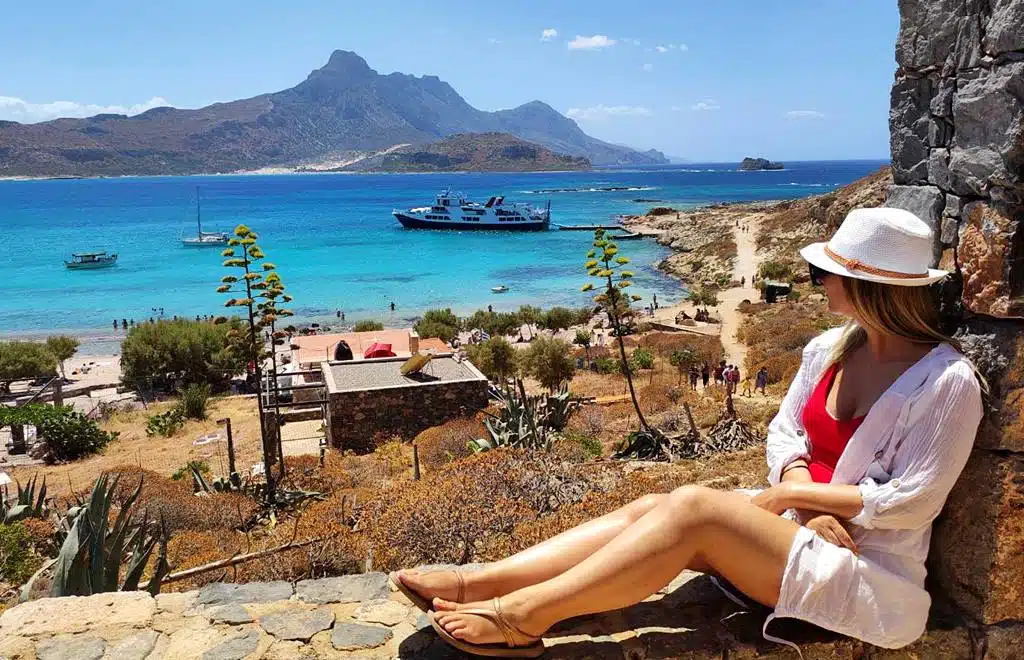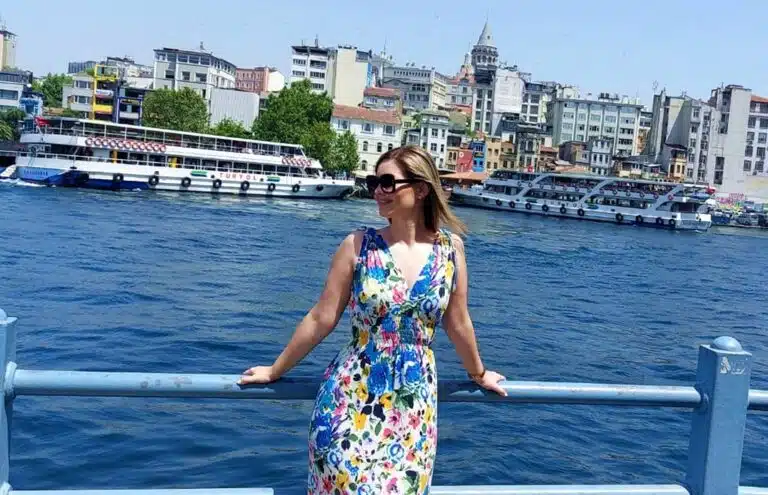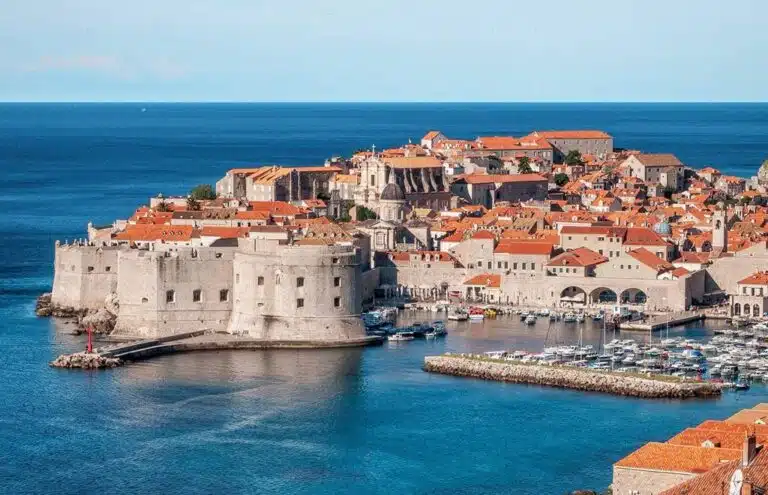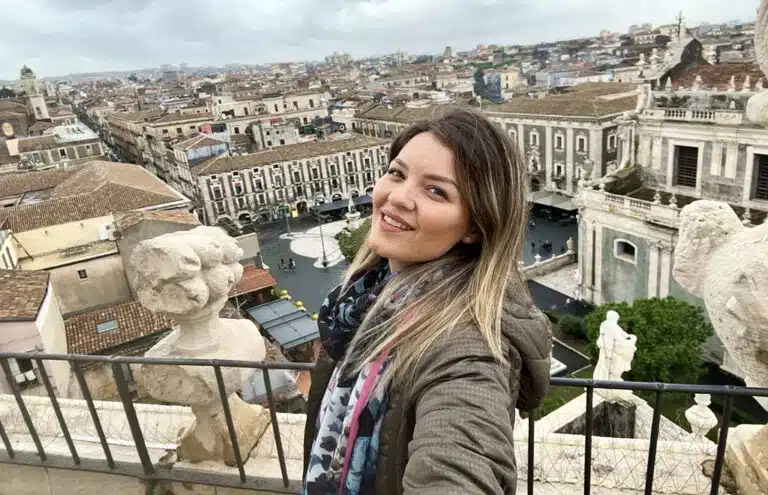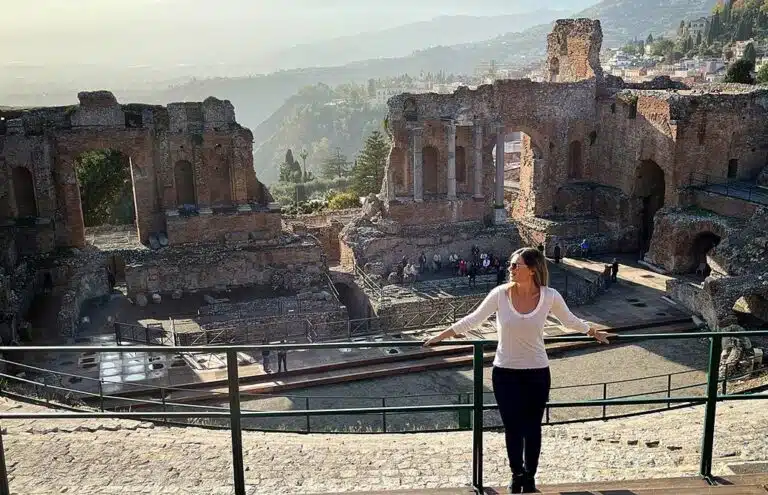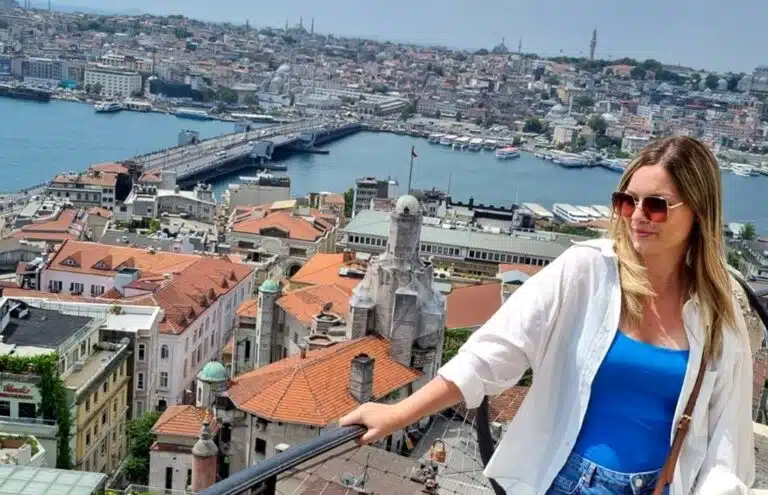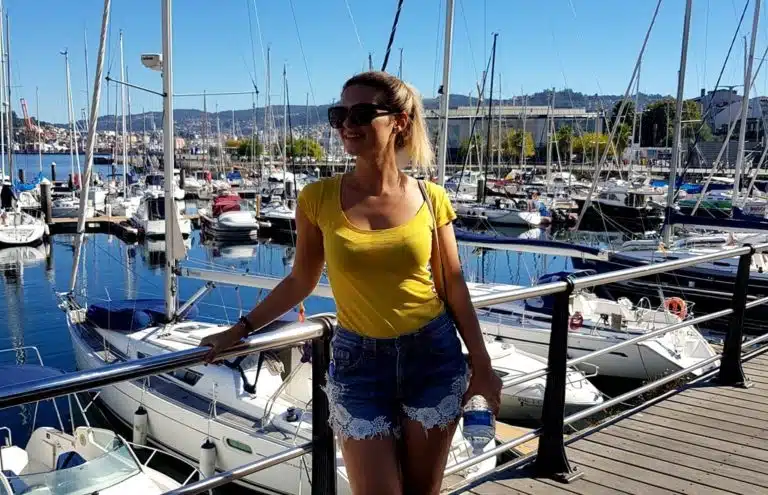15 Best Things to Do In Crete From Rethymno, Chania and Heraklion
Welcome to Crete, the largest Greek and fifth-largest island in the Mediterranean after Sicily, Sardinia, Cyprus and Corsica.
Even though the first association of Crete is its endless coastline, breathtaking beaches, majestic sceneries and upscale holiday resorts, this impressive island offers so much more!
Crete was the center of Europe’s first advanced civilization, the Minoan civilization, whose earliest beginnings date from c. 3500 BC.
A cave in the Cretan mountains was also the birthplace of Zeus, the chief Greek deity and father of all gods and humans.
Fodele, a small village near Heraklion, was the birthplace of Doménikos Theotokópoulos, world-known as El Greco, the Greek painter, sculptor and architect of the Spanish Renaissance.
I recently had the incredible opportunity to spend eleven unforgettable days exploring Crete.
In this article, I’ll share my top travel tips, the best places to stay, must-see attractions for your first visit, and a detailed Crete itinerary to help you make the most of your trip.
Where to Stay In Crete
Crete is a huge island spanning 260 km/160 miles from east to west and, on average, 60 km/37 miles from north to south.
It boasts a coastline stretching 1,046 kilometers (650 miles) and is situated in the southern Aegean Sea, which acts as a natural divider between the Aegean and Libyan Seas.
Crete is one of Greece’s 13 regions and is divided into four regional units: Chania, Rethymno, Heraklion, and Lasithi (the capital city of the Lasithi region is Agios Nikolaos).
The capital city of Crete is Heraklion, located on the island’s northern coast.
These four main cities are connected via the National road E-75 as shown in the map below. The rest of the roads are regional.
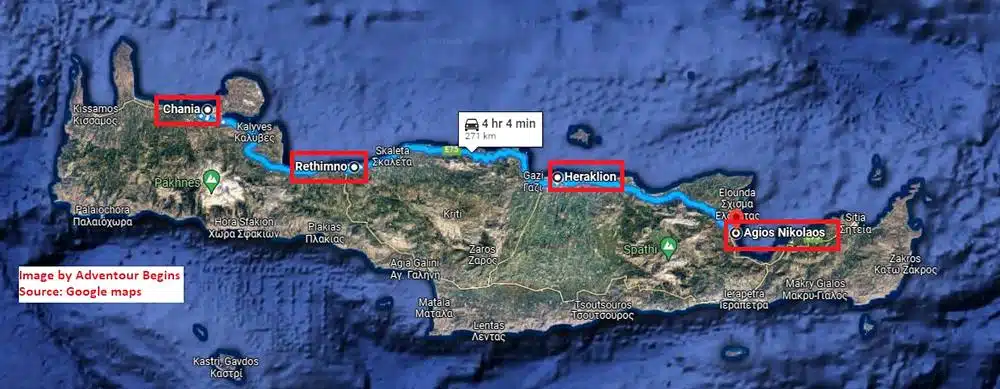
As you can see, Crete is huge and it takes several times to come to the island if you want to visit it entirely. However, if you are traveling to Crete with family or for the first time, I highly suggest you stay in Rethymno, as it is a great starting point to explore the rest of the island.
Rethymno has a 12 km long public beach, a beautiful old town, restaurants, cafes, and everything needed for a perfect vacation.
Before diving into Rethymno, let me share the 10-day Crete itinerary that my friend and I followed—it’s packed with amazing experiences and perfect for first-time visitors!
Crete Itinerary (for First-Time Visitors)
If you’re visiting Crete for the first time, it’s highly recommended to explore the island’s main attractions—unless you’re seeking a more unconventional and off-the-beaten-path experience.
Since it was our first time on Crete, we wanted to explore the main attractions while also enjoying some relaxing beach time—after all, that’s what we came for. Rethymno turned out to be the perfect choice for both! In short, this is how we organized our trip:
- Day 1 and 2: Rethymno
- Day 3: Cave of Agia Sophia, Elafonissi beach, Elos village
- Day 4: Chania, Falassarna beach
- Day 5: Spili, Lake Kournas, Georgioupoli
- Day 6: Balos and Gramvoussa Island
- Day 7: Santorini
- Day 8: Heraklion, Knossos
- Day 9 and 10: Rethymno
Before I write you more about all these destinations, it’s important to take into account some useful travel tips when it comes to Crete:
Crete Travel Tips
- The currency in Greece is the EURO (€). You’ll find ATMs and exchange offices in the majority of the places you’re staying at. Local currency and credit cards are widely accepted.
- The best way to explore the island is by car. You’ll find many car rental agencies practically everywhere, however, the majority of them will ask you to pay a deposit which is not recommended. When booking a car, make sure you are fully insured. Keep in mind that car insurance doesn’t cover off-road accidents and damages. Book Crete rent a car online
- The roads on Crete are in good condition. There is a national road E-75 connecting Chania, Rethymno, Heraklion and Agios Nikolaos (no tolls), and many regional roads connecting these centers to the towns, villages, resorts and beaches in other parts of the island. Be ready to drive long distances. Make sure you download the Crete map before you hit the road: https://maps.me/
- The island of Crete may get extremely windy. This is actually the only thing we disliked about the island. It was so windy for the first few days when we arrived, that we couldn’t swim at all. Depending on the wind intensity, the beaches can be assigned red flags (swimming is prohibited), yellow flags (you can swim with caution) and green flags (swimming is allowed). The windy season in Crete is normally in July and August. When planning your itinerary, make sure you previously check the weather forecast on https://poseidon.hcmr.gr/
- The public transport in the town of Rethymno is very efficient. A one-way ticket costs 1.5€ and buses run every 20-30 minutes. You can purchase the tickets at kiosks that you’ll find at bus stations, or some regular grocery shops and supermarkets. The main cities on the island are well connected by bus and I suggest you check with the main Rethymno bus station (address: Leof. Emmanouil Kefalogianni, near old town) for the timetables and itineraries.
- The water on Crete is potable and safe to drink, however, bottled water is recommended.
- There are two main international airports in Crete: Heraklion International Airport “Nikos Kazantzakis” and Chania International Airport “Daskalogiannis”.
Read more about Crete:
15 Best Things to Do In Crete, Greece
Below you’ll find the list of the 15 best things to do in Crete if you are a first-time visitor. We also included a trip to Santorini, a world-class destination, as it’s one of the most advertised excursions on Crete.
1. Rethymno
Rethymno (also Rethimno, or Rethymnon) is a beautiful coastal town and the capital of the Rethymno region. With a population of over 34,000, Rethymno is the third-largest town in Crete, following Heraklion and Chania.
This pretty port town boasts a 12 km long public beach backed by a promenade ideal for sunset walks, cycling and other activities.
Here, you’ll find dozens of waterfront cafes, restaurants, tour agencies, car rentals, supermarkets, hotels, and activities including watersports.
The beach is a mixture of sand and pebbles and is provided with lifeguards, changing rooms, showers, sunbeds, umbrellas, and other facilities.
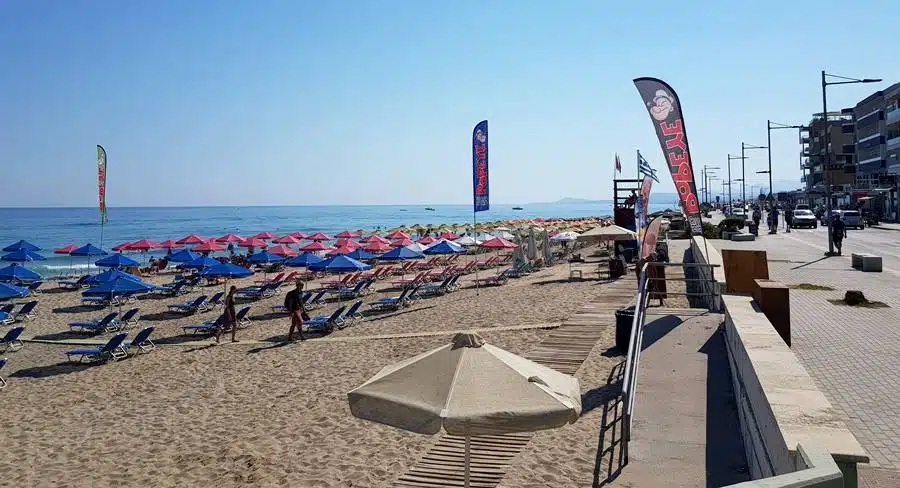
Rethymno has a beautiful marina where the Seajets company operates weekly ferry transfers to the island of Santorini.
This picturesque marina overlooks the old Venetian Harbour with its 19th-century Rethymnon Lighthouse, lined with palms, tavernas, restaurants and shops.
This area is dominated by the striking 16th-century Venetian Fortezza built on a hilltop overlooking the city and the old town.
Rethymno Old Town is a charming maze of narrow cobblestone streets, filled with centuries-old churches, mosques, museums, monuments, and an array of inviting restaurants, cozy cafes, gelaterias, authentic souvenir shops, and boutique stores.
Also, if you don’t mind driving a bit further away from Rethymno, you should not miss visiting the Arkadi monastery, located 20 km/12 miles (a 30-minute drive) southeast of Rethymno. The church dates back to the 16th century and boasts a remarkable blend of Baroque and Renaissance architectural styles.
The monastery played an important role in the Cretan resistance to Ottoman rule in the second half of the 19th century. 943 Greeks, mostly women and children, were hiding from Ottomans in the monastery and after three days of resistance, they decided to sacrifice themselves by blowing up barrels of gunpowder.
They chose death over surrender, and ever since the monastery has become a national sanctuary in honor of the Cretan resistance.
Check out Rethymno tours and activities
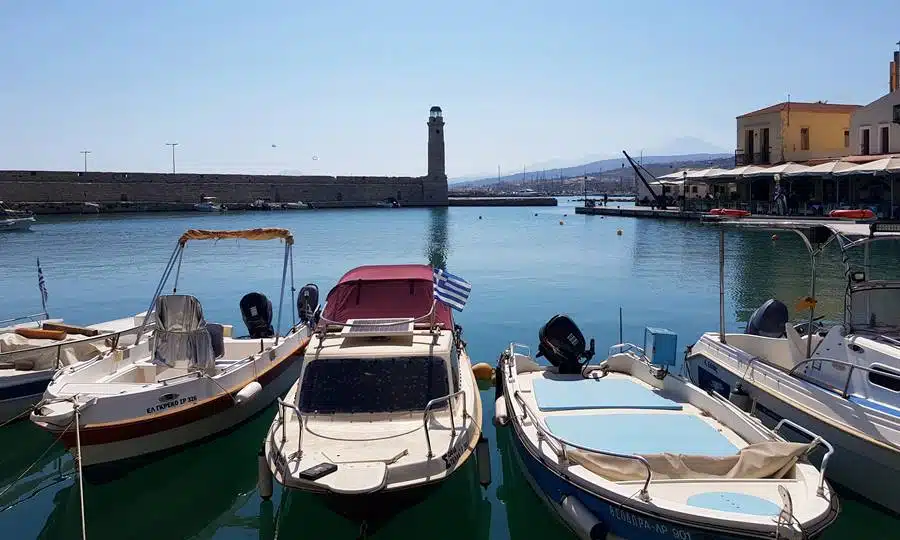
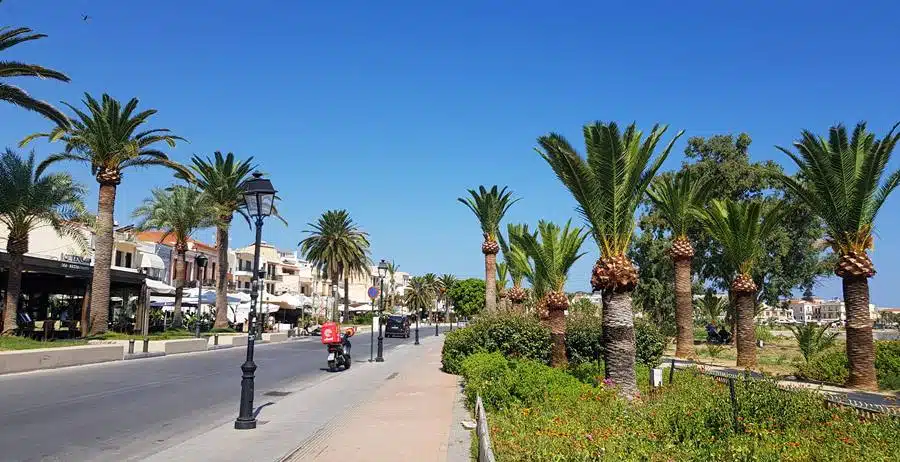
2. Heraklion
Also known as Iraklio, Heraklion is the capital of Crete and its most populous city with more than 210.000 inhabitants.
This port city lies on the north coast of Crete, 80 km/50 miles (a 1-hour 15 min drive) east of Rethymno and 142 km/88 miles (2 hours) east of Chania.
Heraklion is known for the Palace of Knossos, one of the most important archeological sites in the world dating back thousands of years to the Minoan civilization.
The archeological site lies just outside the city and is a must-see place in Crete, along with the Heraklion Archaeological Museum where you can admire the outstanding collections of Minoan art found during the excavations.
Besides these incredible sites, you can walk through the Heraklion old town to Heraklion’s centuries-old Venetian port with its imposing 16th-century Koules fortress.
Explore Heraklion tours and activities
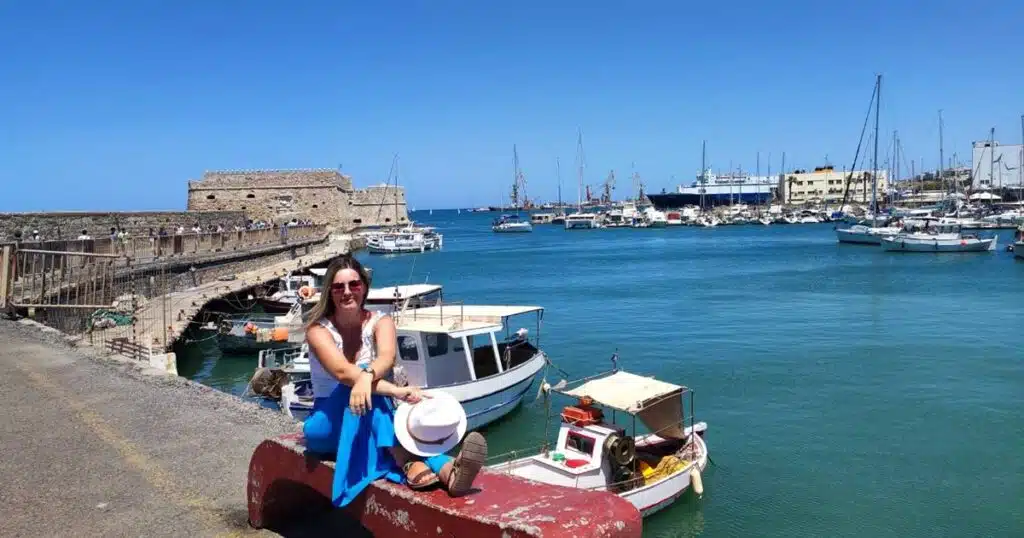
3. Knossos
The Palace of Knossos is the largest Bronze Age archaeological site on Crete whose beginnings date back to the Neolithic period.
The hilltop palace became the political and ceremonial center of the Minoan civilization and culture around 2000 BC and started declining around 1450 BC when, as believed, a devastating earthquake hit and destroyed a large portion of the island.
The Minoan civilization finally ended around 1100 BC, during the early Greek Dark Ages, characterized by the collapse of the Bronze Age civilization.
The Minoan civilization was the first advanced civilization in Europe and Knossos was one of the most powerful cities in the eastern Mediterranean.
At the beginning of the 20th century, the British archaeologist Sir Arthur Evans started the excavations and rediscovered this fascinating civilization that used to have its writing systems, developed trade, economy, sophisticated art and massive building complexes used for different purposes.
Today, visitors can explore the archeological ruins and learn the facts, myths and legends associated with the Minoan civilization.
The artifacts, artworks and objects found during the excavations are kept in the Archaeological Museum of Heraklion, one of the most spectacular museums you’ll ever visit! You may encounter long queues, so booking the ticket online is advisable. There is large parking available for buses and cars next to the site.
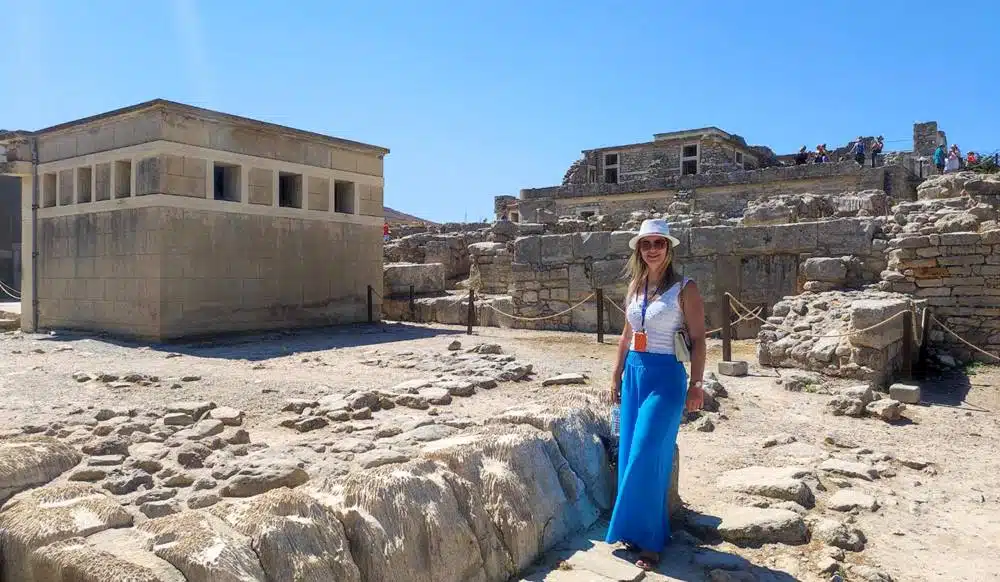
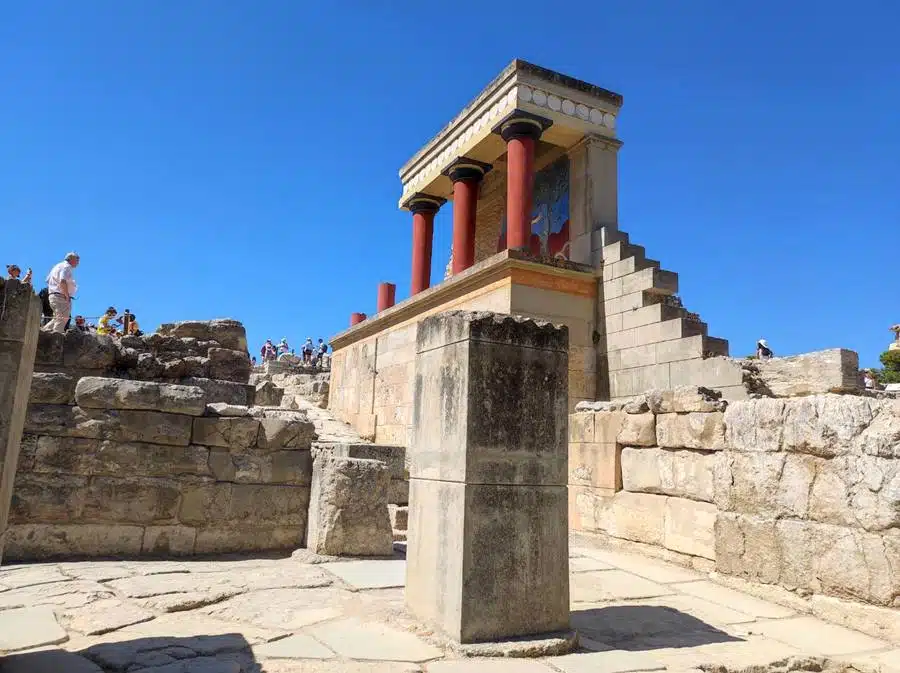
4. Heraklion Archaeological Museum
Housed in a yellow building in the heart of Heraklion city, approximately a 10-minute drive from the Palace of Knossos, the fascinating Archaeological Museum showcases artifacts, art, and objects found during the excavations of Knossos at the beginning of the 20th century.
The museum expands on two levels and consists of numerous rooms displaying outstanding collections from Cretan prehistory and history, with frescoes, sarcophagi, pottery containers, jewelry, figurines, and other valuable items!
It takes around 2 hours to visit and it’s definitely one of the most impressive archaeological museums you’ll ever have the chance to visit!
Heraklion Archaeological Museum tickets, tours and activities
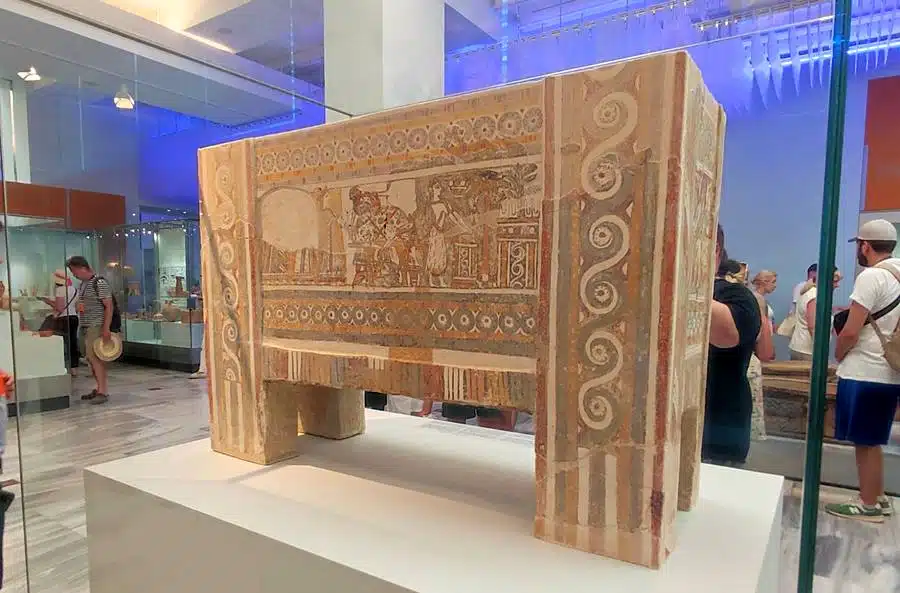
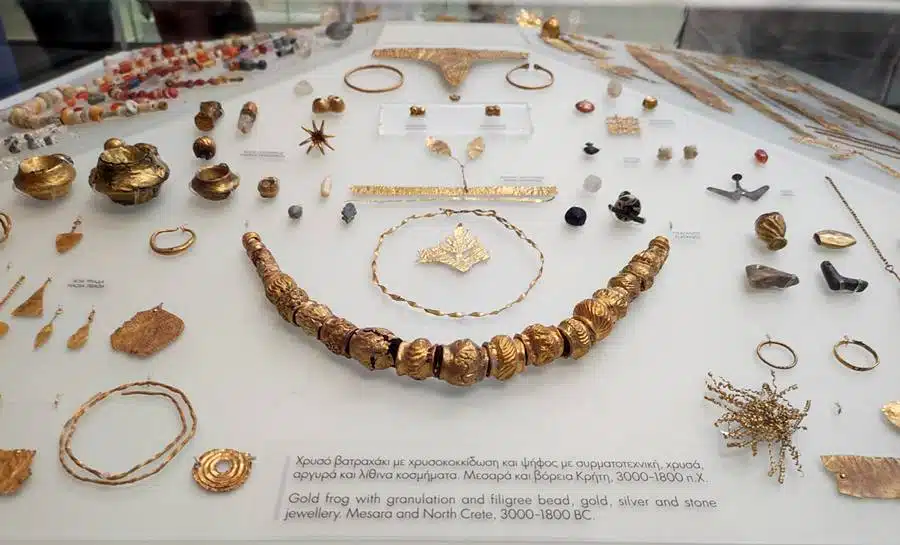
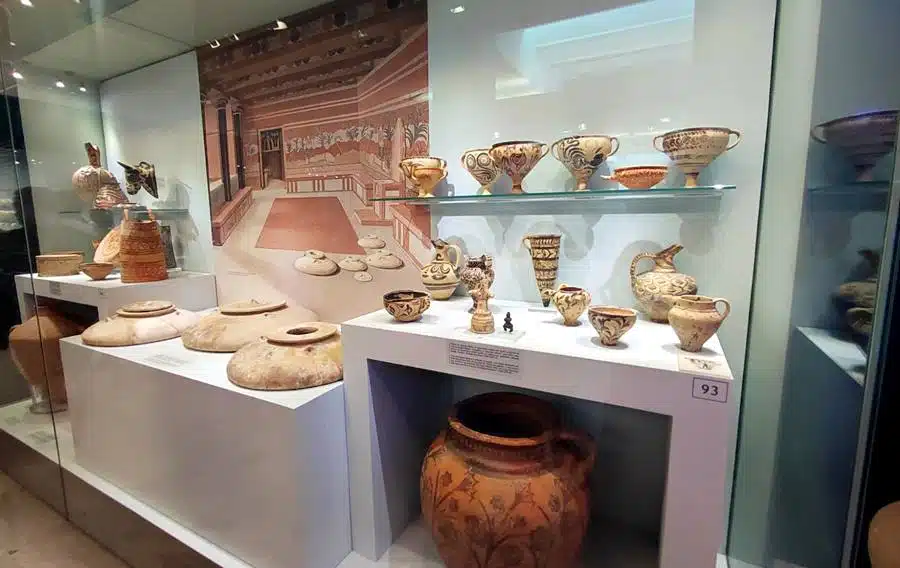
5. Chania
The gorgeous port city of Chania is considered the most beautiful city in Crete due to its interesting past and an extraordinary blend of architectural styles.
Chania lies on the northwest coast of Crete, 66 km/41 miles (a 1-hour drive) west of Rethymno and 140 km/87 miles (a 2-hour drive) west of Heraklion.
Chania is the capital of the Chania region and the third most populous city on Crete island with more than 108.000 inhabitants.
The city is famous for its picturesque Venetian Harbour built in the 14th century for commercial and defensive purposes. The harbour is dominated by the Venetian lighthouse originally dating from the 16th century and walls that you can climb to admire the stunning views of the city.
The current lighthouse was built on top of the original lighthouse’s base in the 19th century by the Egyptians, who were helping the Ottoman Empire to protect Crete (Ottomans occupied Crete in 1645).
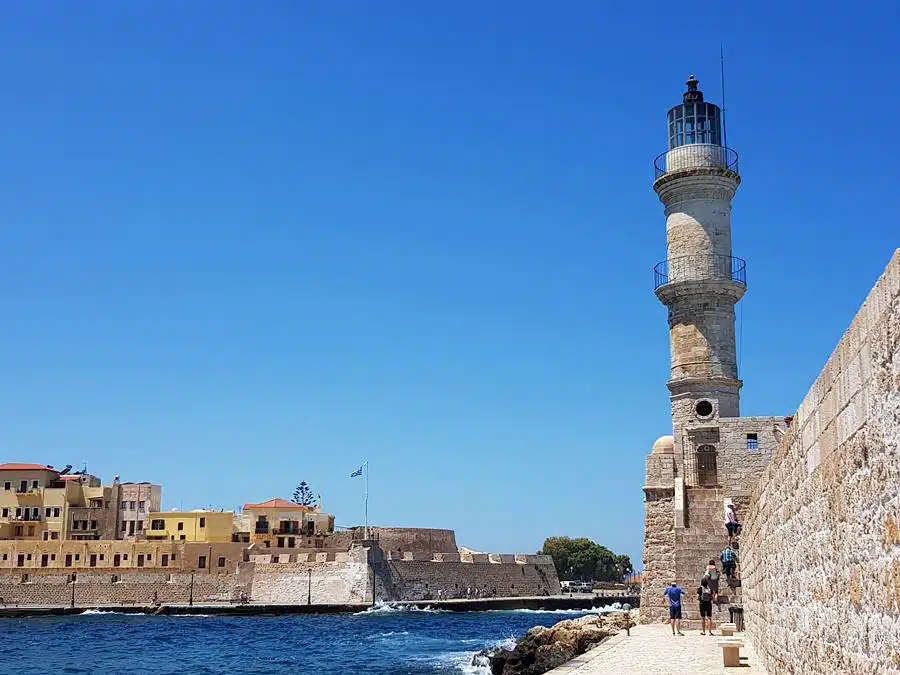
The area around Chania has been inhabited since the Neolithic period. It was the site of the Minoan settlement and throughout history, it changed hands between Byzantines, Arabs, Venetians and Ottomans.
On December 1, 1913, Crete finally united with Greece thanks to Eleftherios Venizelos, the major political figure of the 20th-century European scene who was born in Chania.
Chania’s turbulent history left traces in the city’s architecture, which is considered the top attraction of the city. Roaming Chania’s narrow, old town streets and harbourfront promenade is a true feast for the eyes that offers amazing photo ops.
Eleftherios Venizelos Square is the main square of the city overlooking the harbour, lined with cafes, restaurants, gelaterias, and shops.
In the old town and port area, you can visit the Nautical Museum of Crete, the Folklore Museum, Byzantine/Post-Byzantine Collection of Chania, Chania’s Orthodox Church, Yali Mosque, Center of Mediterranean architecture, the marina, Venetian fortifications, dockyards, and many other landmarks and monuments. All these attractions are located within a short walking distance from each other.
Time permitting, you can visit some of Chania’s museums, churches and art galleries, or simply stroll through the cobblestone old town streets and take in the unique vibe of this charming port city.
If you are considering staying at Chania, keep in mind that the city doesn’t have a public city beach.
Check out Chania tours and activities

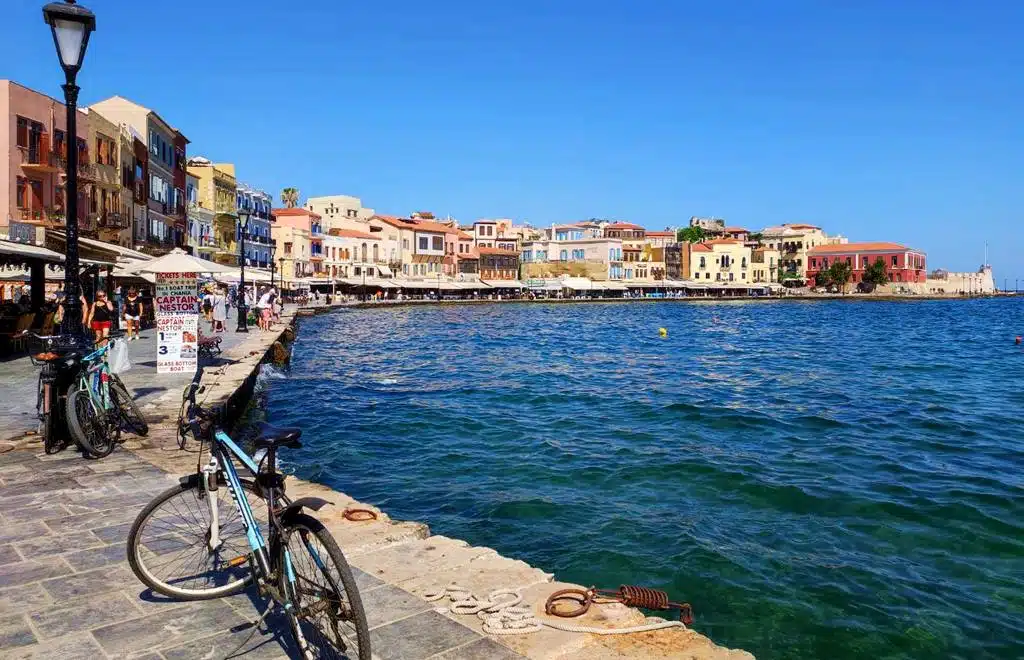
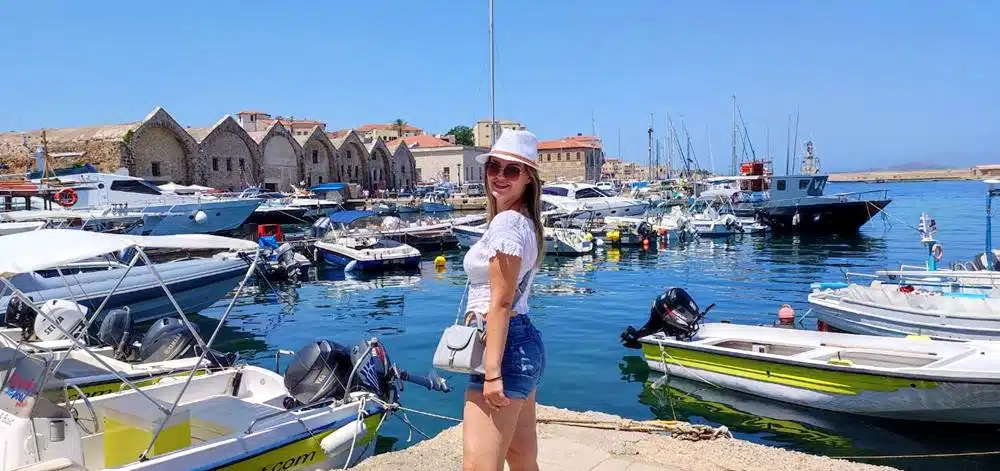

6. Elafonissi Beach
Elafonissi Beach is by far Crete’s most popular beach and one of the most breathtaking beaches in Europe.
It is located in the southwest of the island, 131 km/81 miles (a 2-hour 15 min drive) from Rethymno, 73 km/45 miles (a 1-hour 30 min drive) from Chania, and 211 km/131 miles (a 3-hour 20 min drive) from Heraklion.
Even though it’s far away and the road leads through the mountains and gorges, the beach ranks among the most visited ones due to its pale pink-tinted sands, sweeping dunes and crystal clear waters that earned the beach the nickname “the Greek Caribbean”.
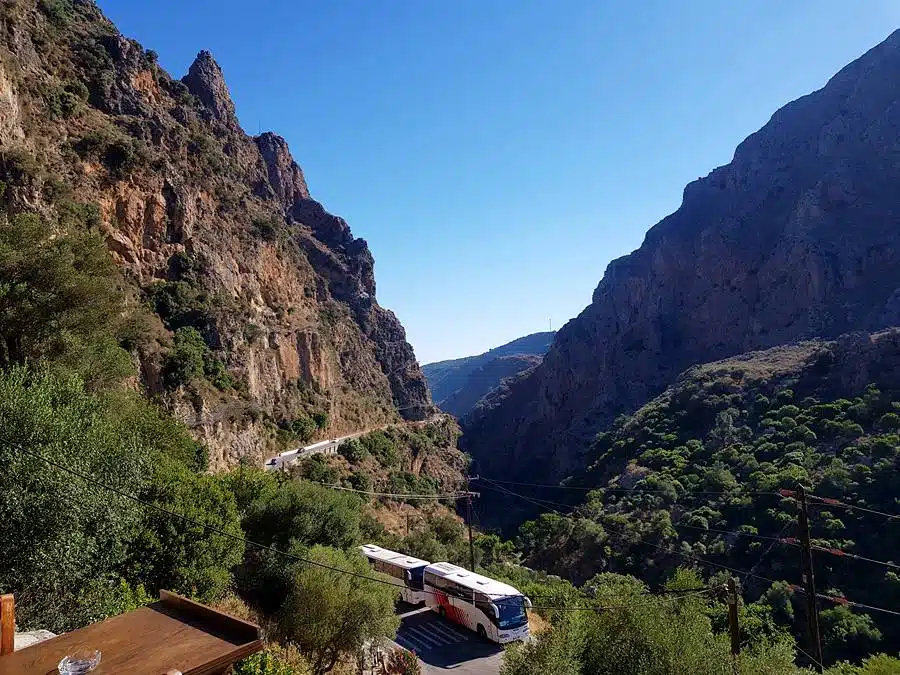
Elafonissi Beach was named after the small islet that is a protected nature reserve, home to a variety of rare plants and wildlife including loggerhead sea turtles.
The islet is separated from the mainland by a shallow lagoon and a strip of white sands which makes this place unique and a true tropical paradise.
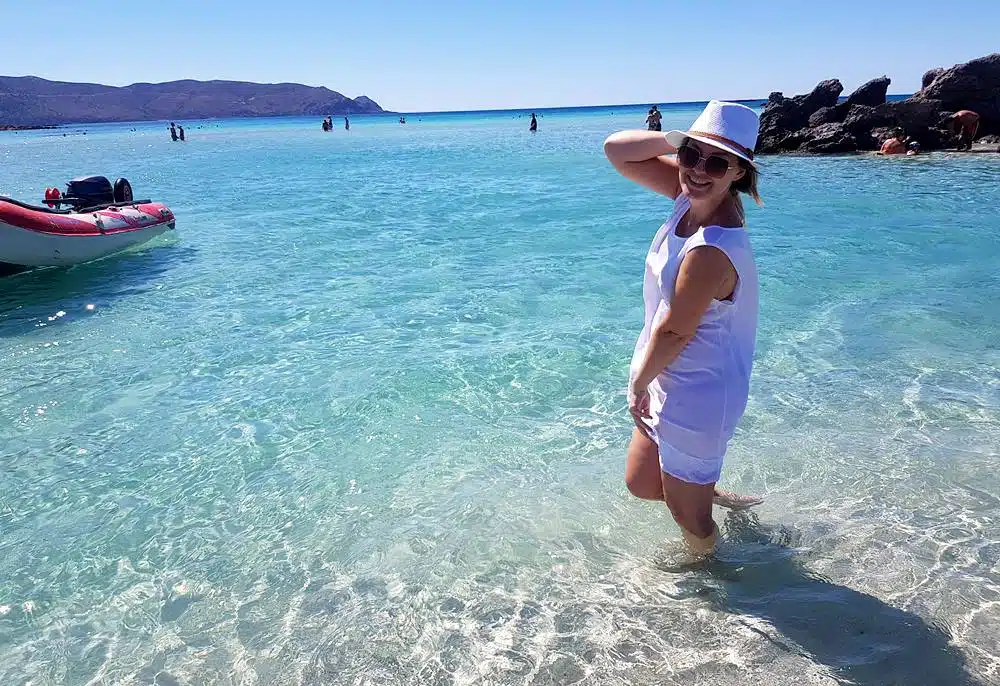
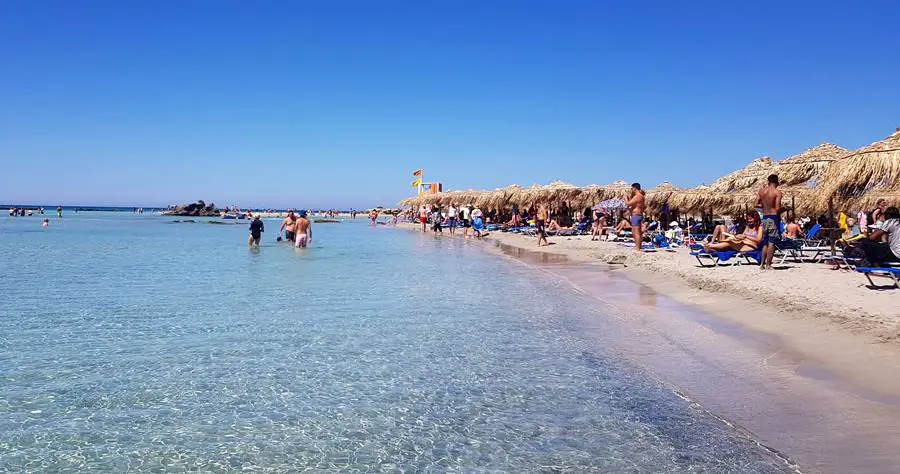
The beach waters are shallow, so you need to walk at least 100 m to reach deeper parts. The beach is particularly famous for its pinkish sands due to the thousands of broken seashells it contains.
Due to its popularity, the beach is usually packed and offers facilities such as sunbeds and umbrellas, a limited number of changing rooms, restrooms, and showers. There is also a snack bar where you can get some food and drinks, as well as a large free parking nearby.
Elafonissi Beach is absolutely worth seeing despite the long ride, however, keep in mind that it may get extremely windy in this area.
7. Balos Lagoon
Balos is one of the most scenic spots and most photographed beaches in Crete.
The famous lagoon is located on the northwest coast of Crete, 110 km/68 miles (a 2-hour drive) west of Rethymno, 52 km/32 miles (a 1-hour 10 min drive) west of Chania, and 190 km/118 miles (a 3-hour drive) west of Heraklion.
The stunning Balos lagoon was naturally formed between the small Cape Tigani and the wild Gramvousa Peninsula.
Balos Beach is famous for its crystal clear turquoise waters, pinkish powdery sands and beautiful mountainous scenery in the background.
The water in the lagoon is shallow and warm, but if you swim further it gets deeper and colder, perfect for snorkeling.

Balos Lagoon is also a protected nature reserve known as the nesting ground for the endangered monk seals and the loggerhead sea turtles (Caretta Caretta).
At the beach, you’ll find umbrellas, sunbeds and only a couple of canteens where you can buy refreshments. If you are planning to eat here, make sure you bring your food.
It is highly recommended to go to Balos by boat. The boats depart from Kissamos port (the town of Kissamos is located 15 km/9 miles southeast of Balos) and it takes around a 1.5-hour boat ride to reach the Balos lagoon.
If you decide to go by car, be prepared for a long and exhausting trip as a large portion is off-road. Once you leave the car at the parking, you need to hike several kilometers to the lagoon which can be extremely tough on hot summer days.

Many local tour agencies offer day trips to Balos. First, they drive you by bus to Kissamos port and then you embark on a ferry for a pleasant 1.5-hour cruise past the Gramvousa Peninsula to the lagoon where you stay for a couple of hours.
The ferry boats are large and have a snack bar where you can purchase food and drinks, including full meals such as moussaka, gyros, stuffed pepper, rice, potatoes and others.
When planning a trip to the Balos lagoon, check the weather forecast in advance as it may get windy and spoil your day in this incredible exotic paradise.
8. Gramvousa Island
The term Gramvousa refers to two small uninhabited islands off the coast of Gramvousa Peninsula in the northwest of Crete: Imeri Gramvousa and Agria Gramvousa.
Whereas Agria Gramvousa is wild and not tourist-friendly, Imeri Gramvousa boasts a picture-perfect beach and hosts the remains of a 16th-century Venetian fort built on a hilltop overlooking the sea.
A trip to Gramvousa is almost always combined with Balos Lagoon and it’s highly recommended to visit due to its extraordinary beauty. There are no facilities at Gramvousa beach.
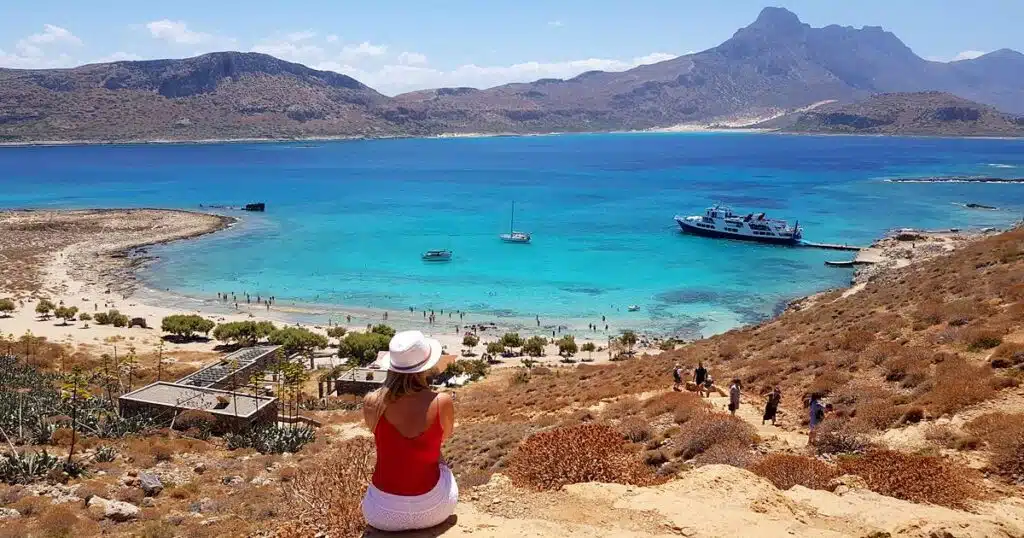
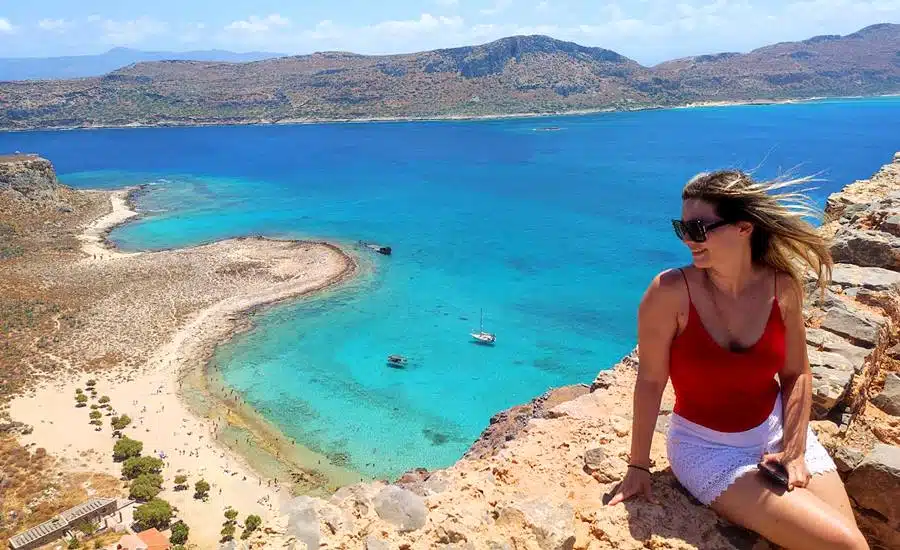
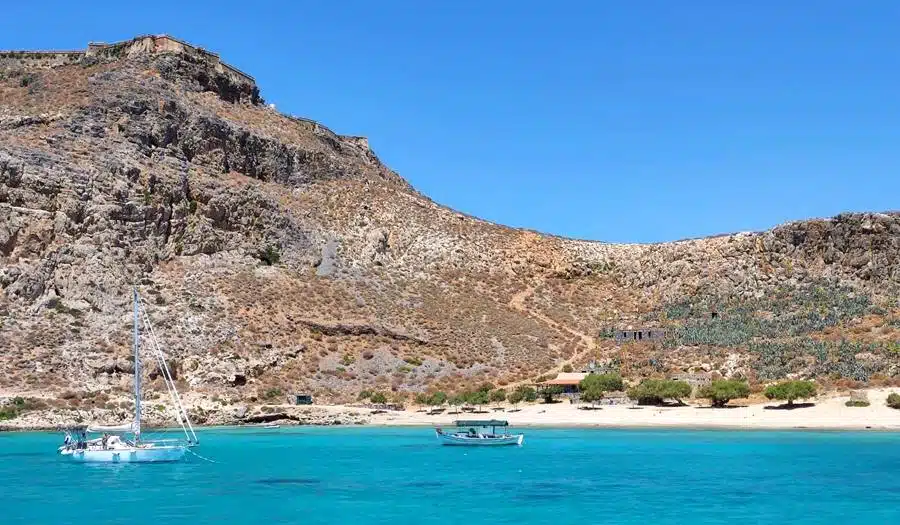
9. Falassarna Beach
Falassarna Beach undoubtedly ranks among the most stunning beaches in Crete and the top 10 beaches in Europe.
It is located near Kissamos town, on the northwestern coast of the island, 114 km/70 miles (a 1-hour 45 min drive) west of Rethymno, 51 km/31 miles (a 1-hour drive) west of Chania, and 189 km/117 miles (a bit less than a 3-hour drive) west of Heraklion.
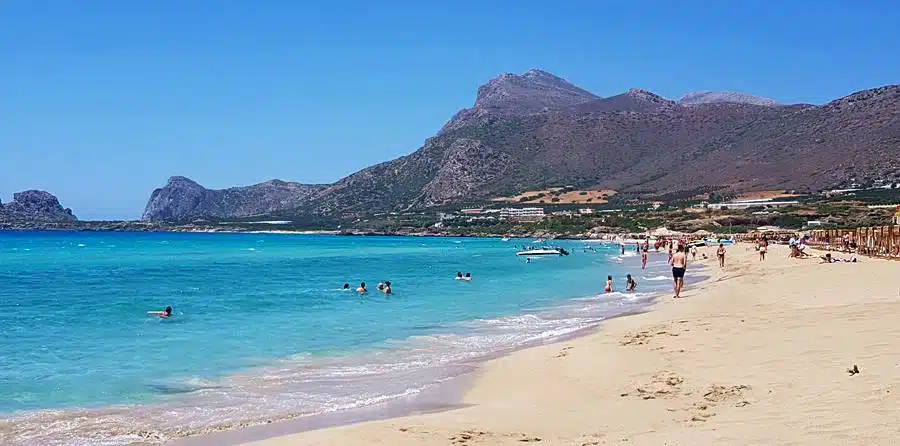
Falassarna is easily reachable by car, although the roads are winding so be mindful of that. The area of Falasarna consists of five gorgeous sandy beaches, with the two most central being the most visited and beautiful ones.
Due to the large area and wide beach, Falassarna is rarely crowded which allows you to enjoy your beach day to the fullest.
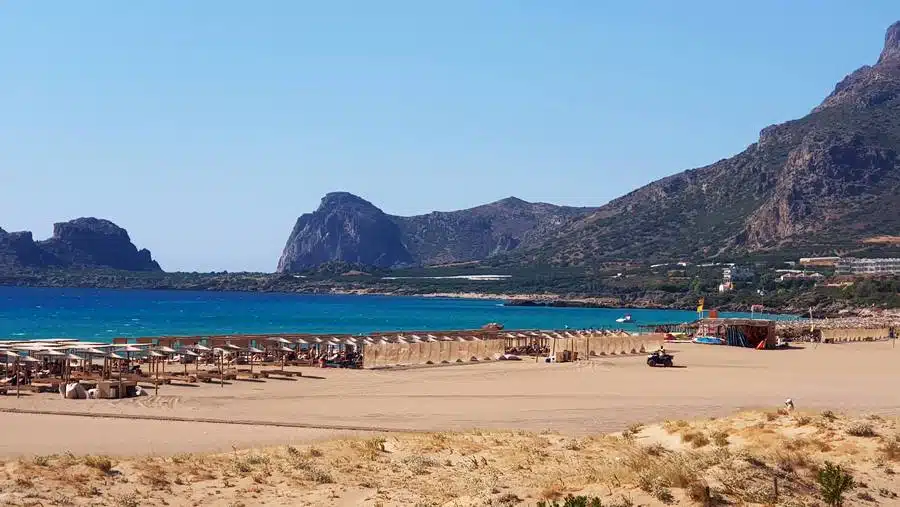
Here, you’ll find facilities such as comfy sunbed/umbrella sets, beach beds, changing rooms, toilets, showers and a couple of amazing beach bars, taverns and cafes where you can relax and enjoy the local vibe. We spent the day at Liokalyvo Beach Bar and absolutely loved it!
Again, when planning a trip to Falassarna Beach, make sure you check the weather forecast as winds can be pretty strong here.
10. Preveli Palm Beach
Preveli Beach is one of the most popular and beautiful beaches on the south coast of Crete.
This picturesque place is located 37 km/23 miles (a 45-minute drive) south of Rethymno, 92 km/57 miles (a 1-hour 30 min drive) southeast of Chania and 114 km/71 miles (a 1-hour 45 min drive) southwest of Heraklion.
The beach of Preveli is located at the exit of the wild Kourtaliotikos Gorge where the Kourtaliotis River meets the sea, creating a unique mixture of the sandy beach and the 500 m long green river flanked by palm forests and rocky surroundings.
The beach is sandy with pebbles and the water is crystal clear, however, it can be slightly cooler due to the river. In the eastern part of the beach, there is a beautiful large rock in the shape of a heart offering amazing photo ops. This whole area is protected and there are no facilities.
Preveli can be reached either by car or boat. In case you decide to take a car, you should drive to the Monastery of Preveli and after 1.5 km you’ll see a parking lot, after which you’ll walk down to the beach for about 15-20 minutes.
Alternatively, you can take a taxi boat from Plakias or Agia Galini taking you directly to Preveli beach.
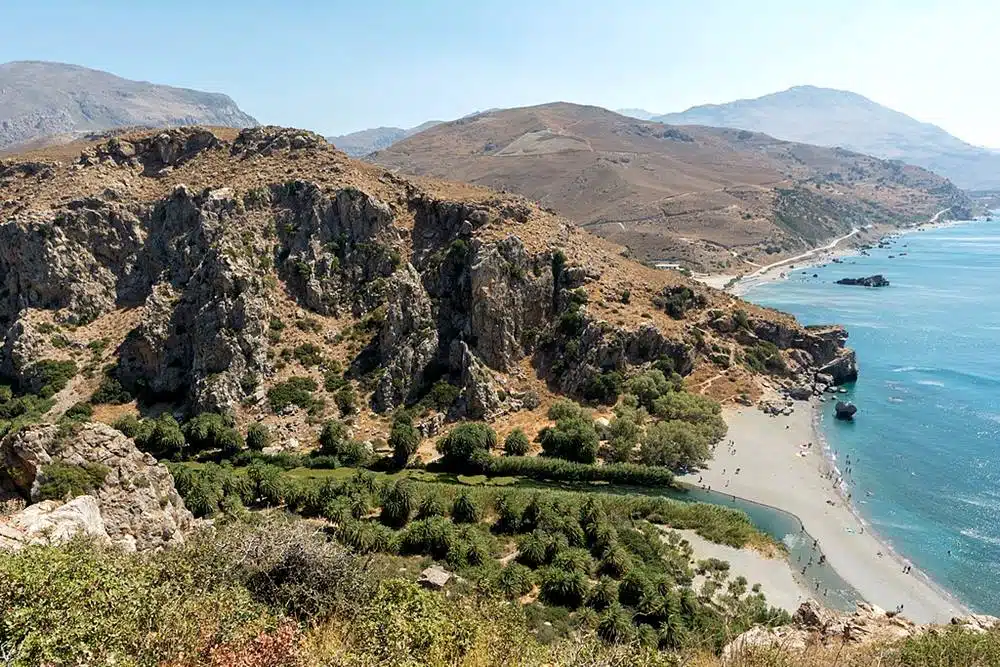
On your way to Preveli Beach, you can visit the historic monastery of Preveli. Preveli monastery is a men-only monastery that was probably founded in the 16th century during the Venetian rule by a feudal lord known as Prevelis.
The monastery consists of two main building complexes: the Kato (Lower) Monastery of Saint John the Baptist, and the Piso (Back) Monastery of Saint John the Theologian.
11. Spili
Spili is a charming authentic Cretan village nestled in the foothills of Psiloritis mountains in the heart of Crete island.
It is located 30 km/18 miles (a 30-minute drive) south of Rethymno, 85 km/53 miles (a 1-hour 20 min drive) southeast of Chania and 107 km/66 miles (a 1-hour 30 min drive) southwest of Heraklion.
The traditional village is famous for the Lions Fountain, a series of twenty-five lion heads with refreshing spring water coming out of lions’ mouths. Unlike other islands, Crete is rich in natural resources including the natural springs so running water is truly appreciated.
In Spili, you can visit the Folk Museum, a picturesque Agios Pavlos church, or the Holy Monastery of Saints Rafael, Nicholas and Irene.
While there, make sure you check out lovely souvenir shops, wander through the quiet narrow alleys and grab a coffee or freshly squeezed juice in one of the village’s charming cafes.
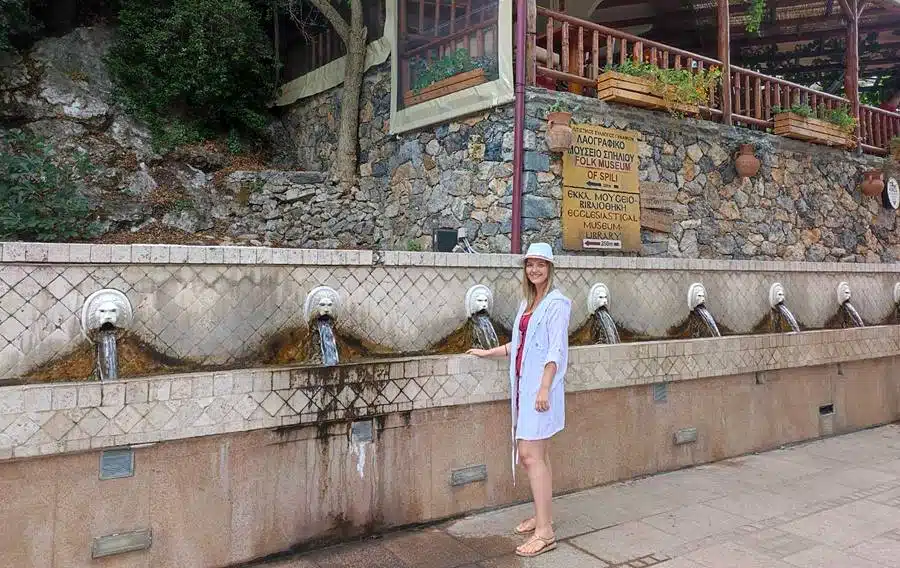
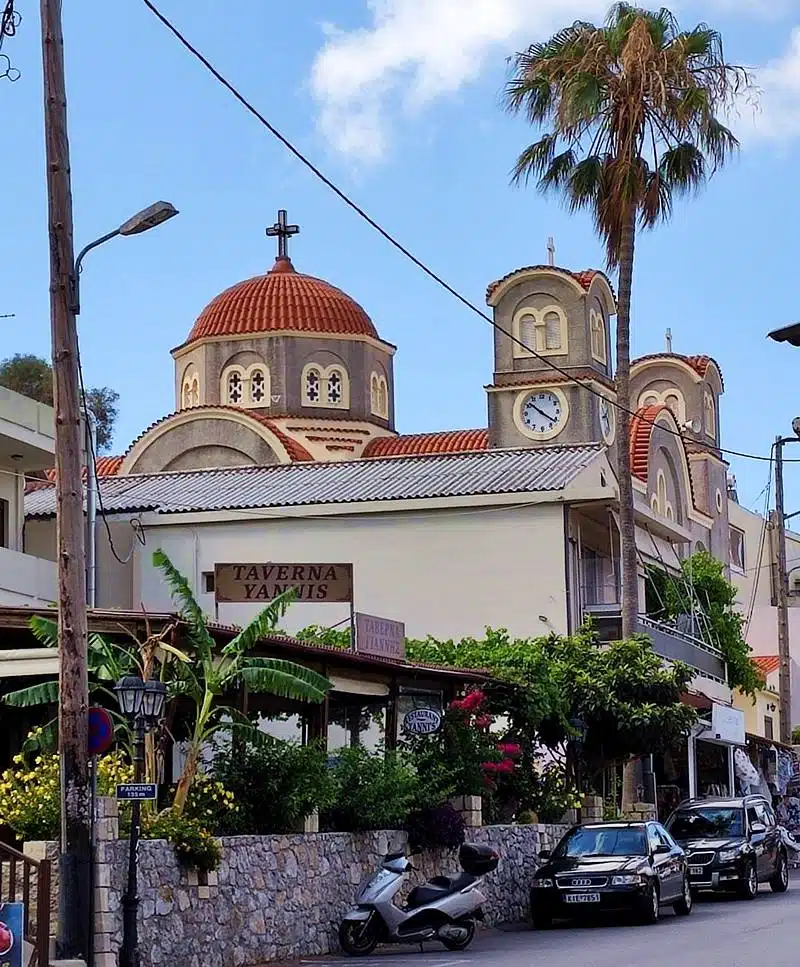
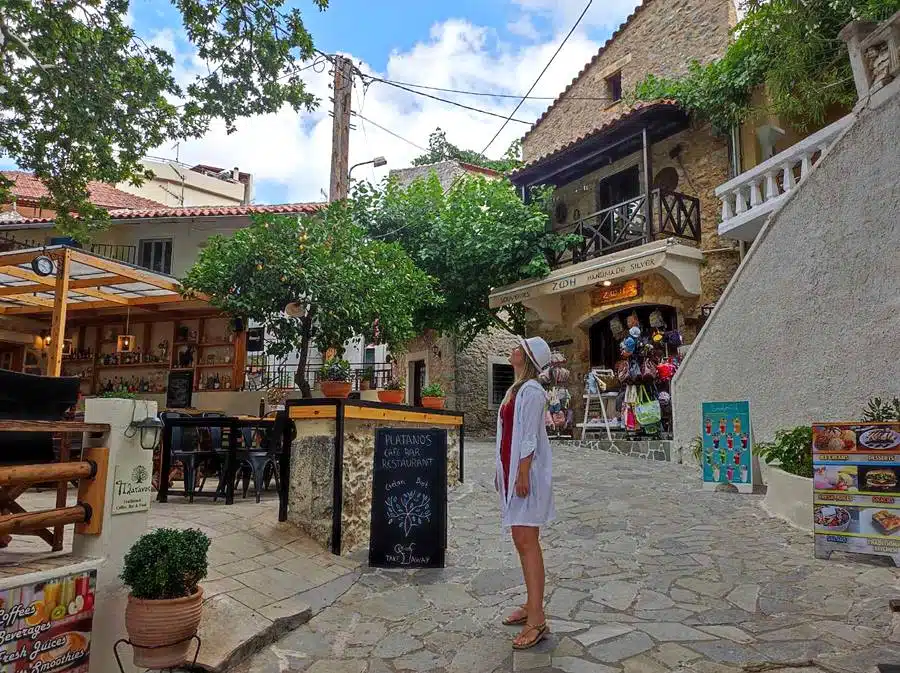
12. Kournas Lake and Georgioupolis
If you are searching for untouched beauty and natural landscapes, you should head out to Lake Kournas, the only freshwater lake in Crete created by the snow melted from the surrounding mountain peaks (yes, there’s snow on Crete’s mountain peaks!).
Lake Kournas is located near the village of Kournas, 27 km/17 miles (a 30-minute drive) west of Rethymno, 43 km/27 miles (a 45-minute drive) southeast of Chania and 102 km/63 miles (a 1-hour 30 min drive) west of Heraklion.
Kournas Lake is quite large, with a perimeter of 3.5 km, and is an ideal alternative for beaches on windy days as it’s nestled in a valley surrounded by high mountains. There are two springs on its southeast bank which feed the lake by streams from the neighboring mountains and hills.
The water in the lake is warm, clear and turquoise. On the southwest side of the lake, there is a nature reserve that is home to turtles, eels, water snakes, ducks and some rare species of turtles.
In the area, you can find taverns, cafes and shops, while in the lake you can swim or rent a pedal. It’s a great place to spend a day in a natural setting different from the typical landscapes we are used to on an island.
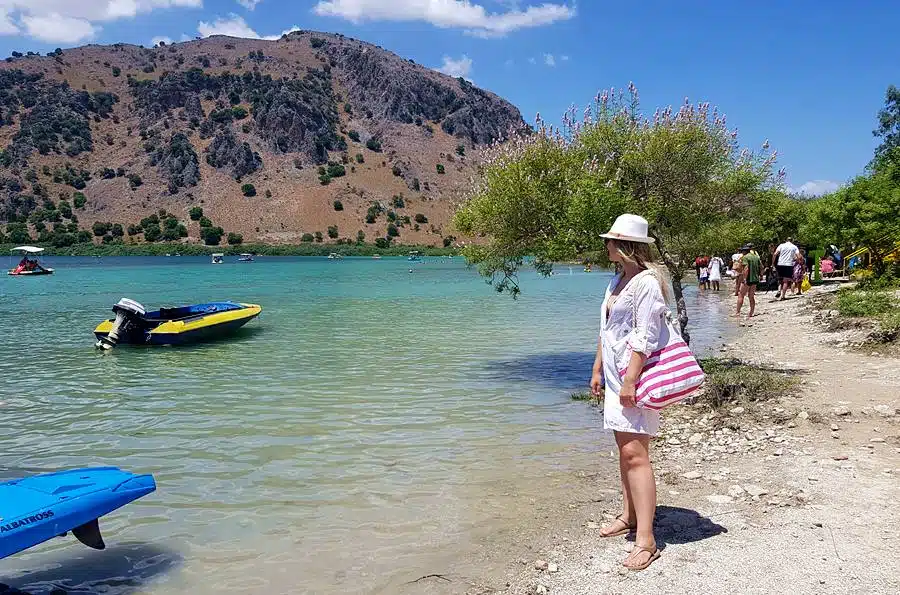
At approximately 5 km/3 miles north of the lake, Georgioupolis is a beautiful seaside resort that you should definitely visit if you have time!
It is a resort village with a beautiful beach lined with restaurants and cafes, as well as a charming old town where you’ll find shops, taverns, tour and car rental agencies, supermarkets and hotels.
Georgioupolis has a small harbour, and the most interesting and photographed landmark is the Chapel of Agios Nikolaos which stands in the middle of the sea. You can walk to the Chapel on a rocky pathway, however, it’s very slippery because of the waves crashing onto the rocks.
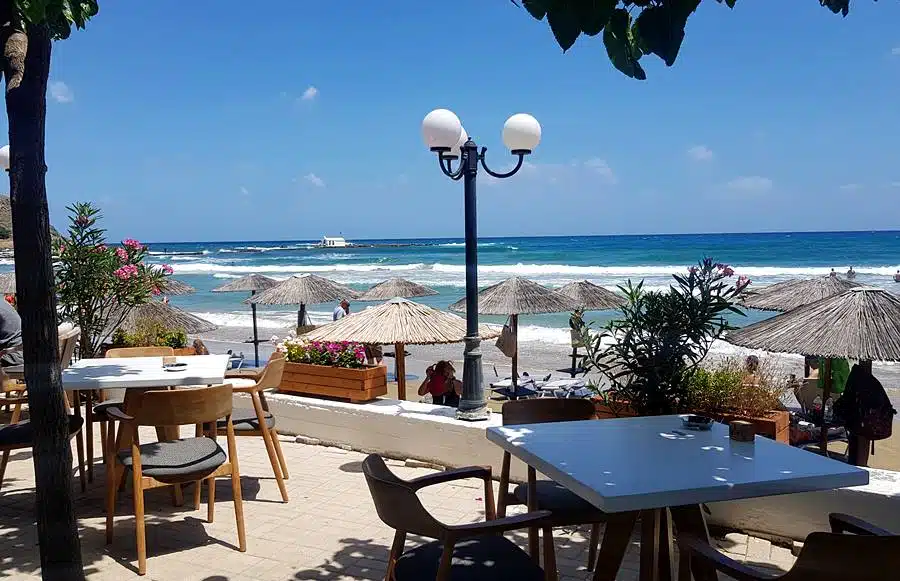
13. Baja Beach Club
If you want to spend a relaxing day at the beach, Baja Beach Club is a cool place where you can unwind and enjoy your beach break to the fullest.
The beach club has many facilities including a large pool, a restaurant, a snack bar, a cafe, access to the beautiful beach, umbrella/sunbed sets, changing rooms, showers, etc.
The beach club is practically open until midnight and there’s music playing all day long so you can stay until late hours if you wish.
My friend and I had an amazing time here and highly recommend it! Baja Beach Club is located only 3 km from Rethymno (a 5-min drive) and you can get there either by car or a local bus that runs every 20-30 minutes from Rethymno.
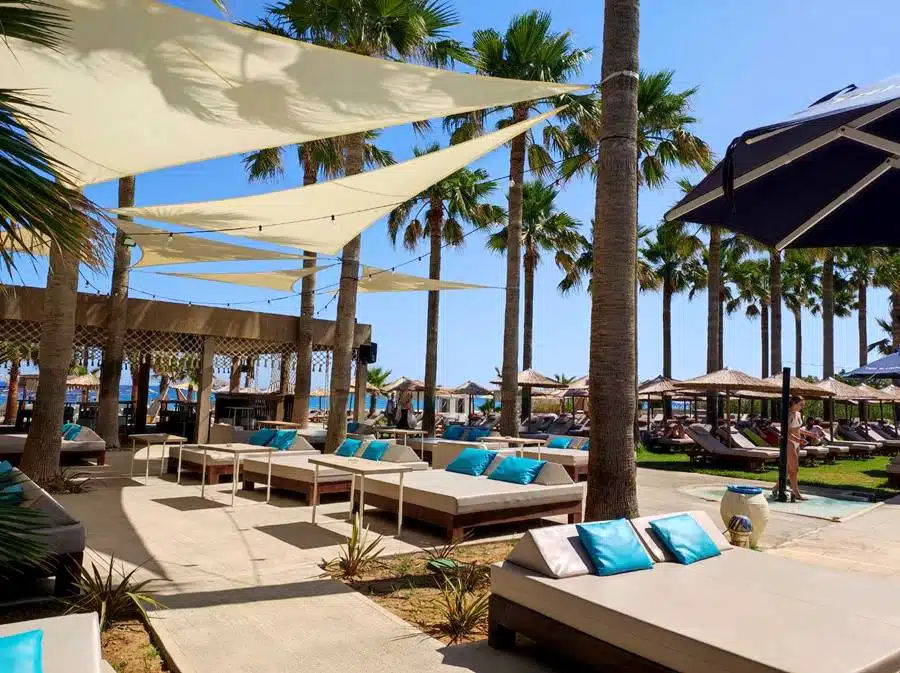
14. Indulge in the Greek Cuisine
Greek cuisine is various and absolutely delicious! Wherever you go on Crete, you’ll find restaurants and taverns offering all types of food, from traditional Greek dishes such as gyros, souvlaki, moussaka, and Greek salad, to international dishes including pasta, pizza, different salads and so much more!
Besides fresh seafood and fish specialties, pork and lamb dishes are also popular in Crete, so make sure you try the traditional lamb “Kleftiko” roasted with garlic, tomatoes, peppers and potatoes (in the picture below in the middle).
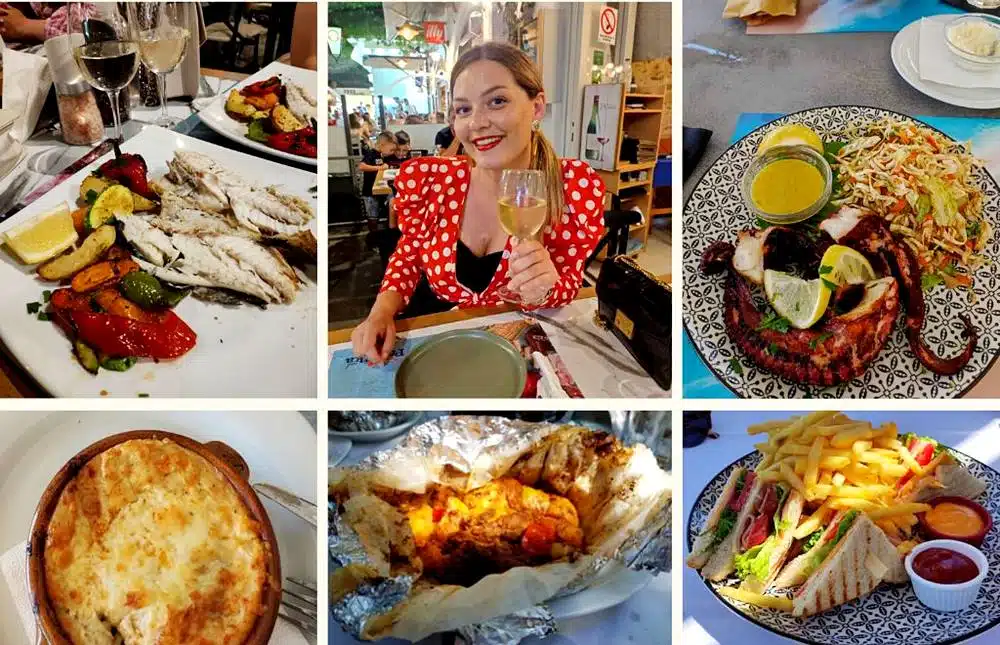
We went to several restaurants in Rethymno and we particularly liked the waterfront “Mediterranean Restaurant” (address: Ari Velouchioti 12, Rethymno) located on the Rethymno promenade, and Red Paprika in Rethymno Old Town (address: Μεσολογγίου 12, Rethymno).
We ate here a couple of times and loved the food! Some other restaurants we enjoyed in Rethymno were Agrilia, Remezzo Seafood Restaurant, Hari’s Creperie and a few others.
The cutest moment is that you’ll probably get the dessert “on the house” after you finish your meal in almost all restaurants, so it’s always nice to leave appreciation tips once you finish.
The food and service in Crete are generally great, so be ready to be treated like a king/queen! And of course, don’t forget to try Cretan olives and wines, as they are believed to be the best in Greece!
15. Santorini
Officially called Thira, Santorini is a top-class world destination and one of the most expensive Greek islands.
Santorini is a small island known for its black-sand beaches and extraordinary rugged landscapes that were created as a result of volcanic eruptions dating from the 16th century BC.
With its magnificent turquoise waters, whitewashed houses, dramatic cliffs and idyllic villages, Santorini ranks among the most photographed places in the world and is a popular cruise port in the Mediterranean cruise itineraries.
Due to its size, the island of Santorini can be visited in a few days, but if you want to take a quick glimpse of it – you can do it from Crete, as day trips to Santorini are organized by Seajets company weekly from Rethymno, Chania and Heraklion.
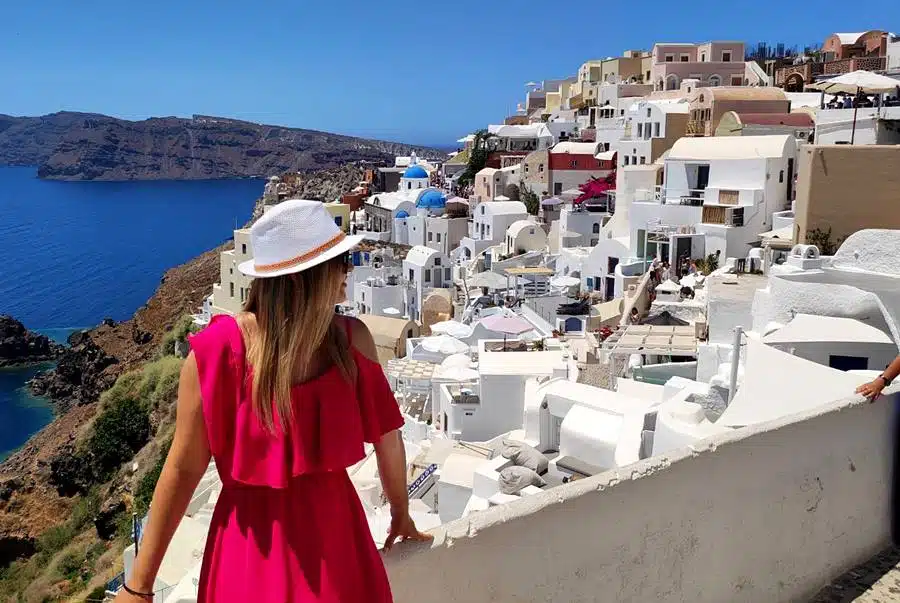
The day trip to Santorini from Crete is usually a guided tour that includes a short visit to two of the major towns in Santorini: Fira (the capital) and Oia, known for their blue domes and classic blue and white architecture.
Sometimes, an optional excursion to hot volcanic springs is organized for an extra fee. The ferry ride to Santorini from the port of Rethymno lasts around 3 hours one way, and the time spent in each of the two towns is from 1.5 hours to 2 hours. It’s short but well worth visiting as Santorini is really special and completely surreal!
Santorini island is also known for its exquisite wines and many vineyards and wineries are offering wine-tasting activities.
Check out Santorini tours and activities from Crete

Wrapping Up
I hope my article gave you at least some basic ideas of where to go and what to see in Crete. The island is so immense and spectacular that it should definitely be visited a couple of times.
When planning your Crete itinerary, check out the weather forecast so you can avoid strong winds.
Enjoy your Crete holiday and let me know your thoughts!
You may also like our cruise port guides to the Mediterranean, Caribbean, Northern Europe, USA & Canada, Australia & New Zealand
This article contains affiliate / compensated links. For full information, please see my disclaimer here.


